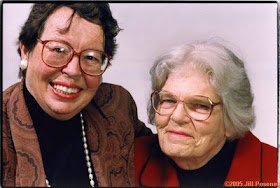SS Sergius & Bacchus: Gay lovers, Roman soldiers, martyrs and saints.
For
St Valentine's day, a partial roll call of same sex lovers (not necessarily genital, but sertainly intimate) in the history of the Catholic Church. There are many others. These are the ones I know:
David &
Johnathan
Ruth &
Naomi
Jesus & the
Beloved Disciple: We cannot know precisely the nature of this relationship, but it was clearly a close one.
Martha &
Mary - Described in the New Testament as 'sisters', but this may have been a euphemism for lesbian lovers.
Philip and
Bartholomew: Included in the Apostles, frequently named in the early liturgies of same-sex union.
Peter and
Paul: Primary apostles, also frequently named in the early liturgies of same-sex union.
The
Roman Centurion and his
"pais" (= slave/lover).
John Finch and Thomas
Baines, buried together in Christ's College Chapel, Cambridge. 17th Century.
Euodia and
Syntyche of Phillippi: a missionary couple active in the early church (?), mentioned in St. Paul's letter to the Philippians (4:2-3)
Tryphaena and
Tryphosa: a missionary couple active in the early church (?), mentioned in in Rom 16
Perpetua and
Felicitas:
Paul and
Timothy:
Tychicus and
Onesimus:
Zenas and
Apollos:
Polyeuct and
Nearchos: third-century Roman soldiers who became saints.
Faustinos and
Donatos: buried together at Phillippi, in Macedonia. 4th century
Posidonia, and
Pancharia: buried together at Phillippi, in Macedonia. 4th to 5th century.
Kyriakos and
Nikandros: buried together at Phillippi, in Macedonia. 4th to 5th century.
Ss Sergius & Bacchus: Roman Soldiers, gay lovers, martyrs - see picture.
Gourasios and
Konstantios: buried together at Phillippi, in Macedonia. 4th to 6th century.
Euodiana and
Dorothea: buried together at Phillippi, in Macedonia. 5th century.
Martyrios, presbyter, and
Demetrios, lector: buried together at Edessa, in Macedonia. 5th to 6th century.
Eudoxios, presbyter, and of the sinner
John, deacon: buried together at Edessa, in Macedonia. 5th to 6th century.
Droseria and
Eudoxia: buried together at Edessa, in Macedonia. 5th to 6th century.
Athanasios and
Chryseros: buried together at Edessa, in Macedonia. 5th to 6th century.
Alexandra and
Glukeria: buried together at Phillippi, in Macedonia. 6th century
St Patrick of Ireland: after his escape from early slavery, Patrick worked for time as a male prostitute. A recent history of Irish homosexualilty suggests that he may have taken a male lover in later life.
Dicul and
Maelodran the wright: buried together in the church at Delgany, County Wicklow.
Ultan and
Dubthach: buried together in the church at Termonfechin, County Louth, near Drogheda.
John Bloxham and
John Wyndham: buried together in Merton College Chapel, Oxford. 14th Century.
King Edward II and
Piers Galveston: well known as gay lovers, their relationship as 'sworn brothers' was recognised by the church.
William Neville &
John Neville: English knights, buried together in Galata, near Constantinople 14th Century
Nicholas Molyneux and
John Winters: made a compact of 'sworn brotherhood, made in the church of St Martin of Harfleur. 15th century.
John Finch and Thomas
Baines buried together in Christ's College Chapel, Cambridge. 17th Century.
Fulke Greville &
Sir Phillip Sidney: the joint monument Greville planned for himself and Sidney in St Paul's cathedral was never built. But the simple intention alone indicates the natrure of the relationship, as also its recognition by the church.
Cardinal John Henry Newman and
Fr. Ambrose St.John: buried together, 19th C.




















